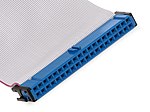Integrated Drive Electronics
 
Two ATA motherboard sockets on the left, with an ATA connector on the right.
|
|||
| Type | Internal storage device connector | ||
|---|---|---|---|
| Designer | Western Digital, subsequently amended by many others | ||
| Designed | 1986 | ||
| Superseded by | Serial ATA (2003) | ||
| Hot pluggable | No | ||
| External | No | ||
| Cable | 40 or 80 wires ribbon cable | ||
| Pins | 40 | ||
| Width | 16 bits | ||
| Bitrate | 16 MB/s originally later 33, 66, 100 and 133 MB/s |
||
| Max. devices | Two (master/slave) | ||
| Protocol | Parallel | ||
| Pin 1 | Reset | ||
| Pin 2 | Ground | ||
| Pin 3 | Data 7 | ||
| Pin 4 | Data 8 | ||
| Pin 5 | Data 6 | ||
| Pin 6 | Data 9 | ||
| Pin 7 | Data 5 | ||
| Pin 8 | Data 10 | ||
| Pin 9 | Data 4 | ||
| Pin 10 | Data 11 | ||
| Pin 11 | Data 3 | ||
| Pin 12 | Data 12 | ||
| Pin 13 | Data 2 | ||
| Pin 14 | Data 13 | ||
| Pin 15 | Data 1 | ||
| Pin 16 | Data 14 | ||
| Pin 17 | Data 0 | ||
| Pin 18 | Data 15 | ||
| Pin 19 | Ground | ||
| Pin 20 | Key or VCC_in | ||
| Pin 21 | DDRQ | ||
| Pin 22 | Ground | ||
| Pin 23 | I/O write | ||
| Pin 24 | Ground | ||
| Pin 25 | I/O read | ||
| Pin 26 | Ground | ||
| Pin 27 | IOCHRDY | ||
| Pin 28 | Cable select | ||
| Pin 29 | DDACK | ||
| Pin 30 | Ground | ||
| Pin 31 | IRQ | ||
| Pin 32 | No connect | ||
| Pin 33 | Addr 1 | ||
| Pin 34 | GPIO_DMA66_Detect | ||
| Pin 35 | Addr 0 | ||
| Pin 36 | Addr 2 | ||
| Pin 37 | Chip select 1P | ||
| Pin 38 | Chip select 3P | ||
| Pin 39 | Activity | ||
| Pin 40 | Ground | ||
Parallel ATA (PATA), originally AT Attachment, is an interface standard for the connection of storage devices such as hard disk drives, floppy disk drives, and optical disc drives in computers. The standard is maintained by the X3/INCITS committee. It uses the underlying AT Attachment (ATA) and AT Attachment Packet Interface (ATAPI) standards.
The Parallel ATA standard is the result of a long history of incremental technical development, which began with the original AT Attachment interface, developed for use in early PC AT equipment. The ATA interface itself evolved in several stages from Western Digital's original Integrated Drive Electronics (IDE) interface. As a result, many near-synonyms for ATA/ATAPI and its previous incarnations are still in common informal use, in particular Extended IDE (EIDE) and Ultra ATA (UATA). After the introduction of Serial ATA (SATA) in 2003, the original ATA was renamed to Parallel ATA, or PATA for short.
Parallel ATA cables have a maximum allowable length of only 18 in (457 mm). Because of this limit, the technology normally appears as an internal computer storage interface. For many years, ATA provided the most common and the least expensive interface for this application. It has largely been replaced by SATA in newer systems.
The PATA standard was originally conceived as the "PC/AT Attachment" because its primary feature was a direct connection to the 16-bit ISA bus introduced with the IBM PC/AT. The "AT" in "IBM PC/AT" refers to "Advanced Technology", but the ATA specifications simply use the name "AT Attachment", to avoid possible trademark issues with IBM.
...
Wikipedia
